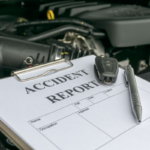Work Zone tickets are the worst kind. Not only do they affect your driving record, but an additional penalty can also put a dent in your savings. For instance, if you are caught overspeeding in a work zone, you may have to pay up to double the penalty of overspeeding on a highway or freeway.
From a safety standpoint, overspeeding in a work zone can be dangerous, especially during peak hours when traffic at the intersection is generally high due to road blocks or diversions. If you are new to driving or the city, it is important to familiarize yourself with work zones and avoid overspeeding or potentially dangerous maneuver that could get you in harm’s way.
Post Contents
Identifying a Work Zone
Every state government defines a Work Zone according to their own jurisdiction. A Work Zone can be considered a stretch between the first upstream sign and the last downstream sign. Since subtle nuances in sign placements might confuse the driver, it is recommended to look for visual cues, such as workers wearing reflective jackets, construction machinery, and traffic cones securing the site perimeter.
As soon as you get these cues, slow down and stay alert for any obstacle in your path.
Work Zone Fines and Points
Every state has different rules and regulations concerning work zone traffic violations. Some states impose fines as low as $25, whereas others can levy up to $500 in penalty for the first offense and a whopping $1000 for the second offense.

Some states, like Arkansas, may even sentence the offender to 3 months of jail time and license suspension.
No matter which state you are in, it is always advised to drive within the speed limits unless it’s a medical emergency. If you are issued a ticket in spite of that, you can contest the ticket in court with the help of The Winit app and specialized lawyers on their team.
Most people try to fight the ticket on their own and often cave in court due to lack of proper knowledge or evidence. On the other hand, traffic ticket lawyers have handled cases similar to yours time and again. They are well-versed in traffic law and know how to use that knowledge to your advantage.
Safety Precautions to Avoid Accidents and Tickets
Avoid Tailgating
Tailgating is a ticketable offense and a dangerous undertaking, particularly in work zones. Driving too close to the vehicle ahead of you in a work zone can lead to a serious accident if they suddenly hit the brakes or change directions to avoid a pothole.
To ensure your safety and that of others around you, maintain at least a 5ft gap from the car in front of you in bumper-to-bumper traffic. When on the highway, this gap should be 50-80ft.
Slow Down
A majority of fatal accidents are caused by overspeeding. As soon as you spot a work zone, consider slowing down. For your convenience, work zones have temporary speed limit signs.
Adhere to the speed limit and avoid frequent lane changes for the safety of workers, pedestrians and other vehicles on the road. Stay vigilant of any potholes or obstacles as you enter a work zone. Most importantly, avoid potholes that are filled with water – you never know how deep they are.
Obey the Flaggers
Flaggers are commissioned by the construction company or the traffic authorities to direct the traffic around work zones. They are deployed to wave Stop/Go signs, signaling the accident-prone zone ahead. Obey them just as you would obey traffic lights, and you’ll be safe.

Do Not Overtake
Overtaking in a work zone not only jeopardizes your safety but also puts other vehicles at risk. A work zone may have potholes, barriers, a rough patch of road or a converging lane. Overtaking in such conditions can lead to a major accident.
Be Prepared for the Unexpected
Work zones are unpredictable. Workers pushing a lopsided wheelbarrow across the street is a common sight, and they might drop a thing or two. Expecting such things to happen as you drive through the work zone will give you the reaction time needed to hit the brakes or swerve just in time to avoid an accident.
Conclusion
Avoid driving through the work zone if you can. However, if taking a detour is not possible, try to be as alert and calm as possible behind the wheel. Respect the speed limit and keep an eye out for pedestrians, construction crew and spillage on the road.






























